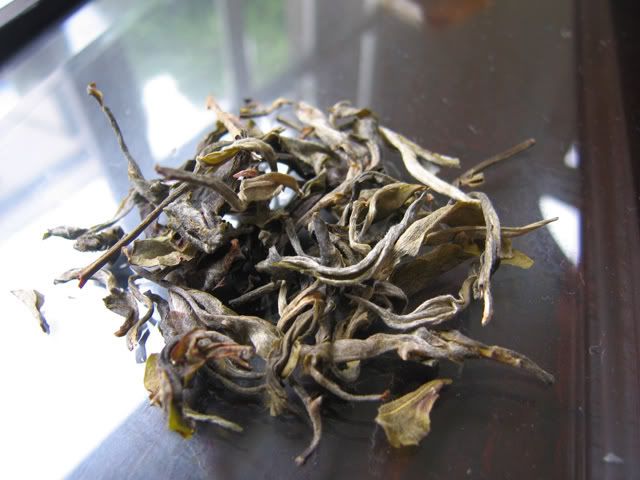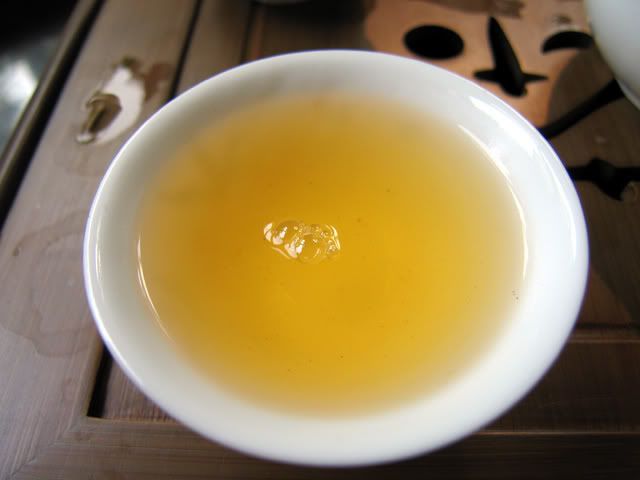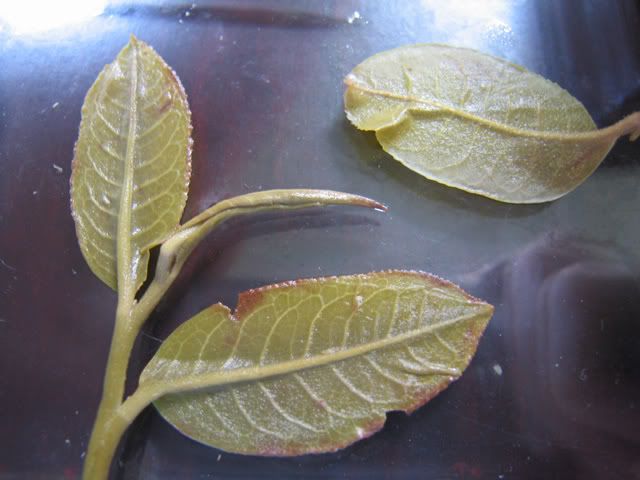Continuing the series — maocha from Gedeng mountain, which is west of Manzhuan and Yibang.


These leaves are heavier than the Yibang ones yesterday, and I’d say more or less on par with the Manzhuan stuff two days ago. There’s more tea in this bag than the last two days, and I foolishly thought I’ll be ok…
The tea brews a more bitter brew than anything that has come along so far. The first three infusions have a floral note to it, although only a fleeting one. The tea is thick, and heavy. You can feel the bitterness going in, covering the mouth, and after swallowing… the huigan comes a little slower than the other maochas I’ve tried so far. There’s a bit of delay for this tea, interestingly enough. When the floral note goes, what’s replacing it is a sort of bitter “tea” taste, for lack of a better word. I really don’t know how else to describe it other than it tastes like… tea. Young puerh tea, sure, but tea. It doesn’t taste like anything else that immediately comes to mind, but it is unmistakably tea.
Now… the huigan is a little more focused on this tea, mostly hitting the area at the far back of the mouth and beginning of the throat in a very small but concentrated fashion. The feeling is long lasting, but it doesn’t extend quite as deep as the Yibang or the Manzhuan. The cha qi is not obvious at first, but after about four or five infusions… it hit me, really, really hard. I was getting dizzy at one point, needing to walk away from the tea and do something else before going back to it. There was definitely a tea high there, and this is rare for just one tea. I would normally get a bit affected by a tea after a few in a long tasting session, but the last time I had this feeling of being hit hard by one tea was … I don’t even remember.
I ended up taking out some leaves to weaken the tea, so that I can continue tasting it to see how it develops. I didn’t last too long after that before calling it quits. It was getting difficult to swallow — not because the tea is bad, but because I could feel myself not handling it so well at this point.
Two shots of the liquor – before and after I took leaves out


Something I have noticed that is common throughout the four teas I’ve had so far — the progress of taste. First you get the “mountain specific” taste from the tea. The teas, as they are spring teas, are smooth. Then in about infusion 4-5, the tea starts getting a little astringent, partly because of the slightly longer brewing time now (depending on the case — 10-15s) and partly because the stuff comes out now no matter what, I think. The mountain specific taste loses a bit of its luster, and slowly changes to the ubiquitous “sweet water” taste that a young puerh will typically get after around infusion 10 or so. By that time the astringency will fade, and you return to a rather pleasant, if slightly more watery, tea. Many younger puerhs, at this point, will be entirely boring to drink and the drinker would’ve given up by now. A truly good one will keep delivering a strong “tea” taste, for lack of a better word, that accompanies the “sweet water”.
I personally think that part of the reason for the high amounts of tea used in such tastings and the relatively short infusion times used is to precisely test how long such teas actually last and how complex it is, without doing the otherwise undrinkable and entirely not-enjoyable 5-minute brews. I could’ve brewed these using the 5-minute method, but it would’ve been very, very boring and a waste of otherwise very fine tea. If I have more of the teas, then I probably could’ve done it as a basis for comparison. Since I only have one sample of each, I wanted to make the most of it. If you add too little leaves, the progression basically gets compressed and the infusion-by-infusion change is not nearly as obvious. Very quickly a tea will get to the “sweet water” stage. While a good tea will still deliver you a nice, pleasant drink, I think the question of HOW a young puerh gets to that point is in many ways more important, because at the end of the day… that’s what people enjoy drinking the most in an aged pureh, not the sweet, rather boring and mellow taste, but the many changing flavours that precede the sweet mellow water that comes at the end of a session.
Anyway… shots of the wet leaves. Slightly different shape again, but largely keeping the same look (except one small leaf). I took pictures of two set of leaves today, because I took some pictures of the leaves I took out the first time, and when I was done, I took more pictures….






And the final picture is of a much drier leaf — you can see the amount of hair on the back of the leaf


1 response so far ↓
HobbesOxon // May 5, 2007 at 12:27 pm |
I sense a new phrase being coined:
Gedeng (v): to brutally slug someone with a surfeit of qi.
Usage: “You’ve been gedeng’d.”
I think you’re right with the “mountain” wearing off after the first few – I see the same thing in the Xizihao Banzhang I just tried, and the Zhengyan samples from Guang.
Toodlepip,
Hobbes